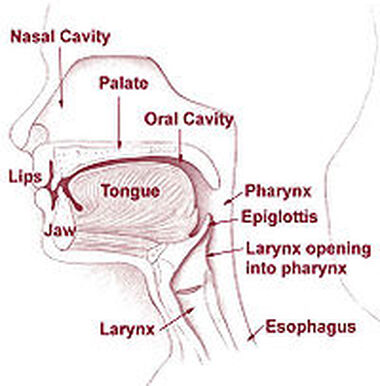What is Mix???
|
In order for any stringed instrument to function efficiently two elements must be present: one, the vibration of the string creating the pitch, and two, the resonance of the instrument creating tone. Like a piano, violin, guitar, harp, cello, viola, etc, the voice is a stringed instrument and depends on these two functions for proper vocalization. When the vocal folds come together, the vibration between them creates a pitch depending on the length, thickness, and tension of the vocal folds. This pitch resonates throughout the body, creating the tone of that pitch.
|
Both of these elements were given equal importance in the original and pure bel canto technique. However, in the late 19th century there was a split within the bel canto world. One group continued on as “bel canto,” focusing more on the resonant portion of the technique and the movement of the resonance behind the soft palate. The other group focused more on the vibration portion of the technique, calling itself “forward singing.” The bel canto group is considered by many today as the style of “classical” singing, and the forward singing has developed into what is more commonly known as “belt” or “broadway belt” singing.
In Mix, we desire to bring the two elements fully back together. “Behind the soft palate” accesses the “head voice” and the “forward singing” brings the vocal folds fully together and accesses the “chest voice.” By mixing the chest and head voice you receive the full benefits of “both voices”: the natural and powerful sound of the chest voice, and the beauty and range of the head voice. As a singer learns to sing using both of these resonances and trains the vocal folds to stay together, it is possible to vocalize smoothly and evenly from one register to the next. The relationship of the two elements working together will create an even, smooth vocalization and, as a result, eliminates the “breaks” in the voice. The “break” is the passagio (passage) that occurs in most singers while attempting to vocalize from one register to the next. The “break” is a common complaint among vocalists. Mix, a balanced and healthy approach to singing, eliminates the “break” in the voice.
Depending on how these two resonances are “mixed,” a variety of sounds can be created and all styles of music can be accommodated. A sound that is natural and unaffected throughout the entire vocal range can be used in all styles of singing.
In Mix, we desire to bring the two elements fully back together. “Behind the soft palate” accesses the “head voice” and the “forward singing” brings the vocal folds fully together and accesses the “chest voice.” By mixing the chest and head voice you receive the full benefits of “both voices”: the natural and powerful sound of the chest voice, and the beauty and range of the head voice. As a singer learns to sing using both of these resonances and trains the vocal folds to stay together, it is possible to vocalize smoothly and evenly from one register to the next. The relationship of the two elements working together will create an even, smooth vocalization and, as a result, eliminates the “breaks” in the voice. The “break” is the passagio (passage) that occurs in most singers while attempting to vocalize from one register to the next. The “break” is a common complaint among vocalists. Mix, a balanced and healthy approach to singing, eliminates the “break” in the voice.
Depending on how these two resonances are “mixed,” a variety of sounds can be created and all styles of music can be accommodated. A sound that is natural and unaffected throughout the entire vocal range can be used in all styles of singing.
THE METHOD
In order to produce a balanced and free tone (especially on high notes) one must avoid tension in the outer muscles of the larynx. Muscles normally used to chew and swallow food are called into use by the singer in order to force the larynx up or down, in order to assist or “improve” the tone. This causes a labored or unbalanced sound.
Mixed Voice is based on the concept of singing in the same comfortable manner as you speak. The use of the outer muscles(extrinsic muscles = swallowing muscles) is eliminated and the vocal cords are allowed to function in their natural manner by making the correct adjustments for the higher notes. The singer does not have to raise the larynx for high notes or lower it for low notes. The larynx stays in a relaxed position throughout the entire range of the singer.
Vocal Bridges Another extremely important focus of Billy's method is the crossing of the singer’s bridges or passage areas (often called the “passagio”). This is where the voice begins to resonate in a different part of the body, and it can be a very tricky area for the singer. The singer often begins to feel the voice build tension here, usually followed by the inevitable “break”, when the voice can carry this build up of tension no higher. To avoid this, as one sings higher, more and more sound should cross behind the soft palate before leaving the mouth. The key to crossing these “bridges” to the new area of resonance is to gradually “mix in" the new resonating area, thereby avoiding a sudden “break” in the voice. The result is a voice that sounds full and connected all throughout it's entire range, with no breaks or sudden shifts in tone.
Billy DiCrosta and his Team of Mix Teachers employee a great number of different exercises to train the voice in these areas. Mix Technique is the key to a relaxed, comfortable singing style with no strain on the delicate vocal cords, thus prolonging the health and life of the voice.
In order to produce a balanced and free tone (especially on high notes) one must avoid tension in the outer muscles of the larynx. Muscles normally used to chew and swallow food are called into use by the singer in order to force the larynx up or down, in order to assist or “improve” the tone. This causes a labored or unbalanced sound.
Mixed Voice is based on the concept of singing in the same comfortable manner as you speak. The use of the outer muscles(extrinsic muscles = swallowing muscles) is eliminated and the vocal cords are allowed to function in their natural manner by making the correct adjustments for the higher notes. The singer does not have to raise the larynx for high notes or lower it for low notes. The larynx stays in a relaxed position throughout the entire range of the singer.
Vocal Bridges Another extremely important focus of Billy's method is the crossing of the singer’s bridges or passage areas (often called the “passagio”). This is where the voice begins to resonate in a different part of the body, and it can be a very tricky area for the singer. The singer often begins to feel the voice build tension here, usually followed by the inevitable “break”, when the voice can carry this build up of tension no higher. To avoid this, as one sings higher, more and more sound should cross behind the soft palate before leaving the mouth. The key to crossing these “bridges” to the new area of resonance is to gradually “mix in" the new resonating area, thereby avoiding a sudden “break” in the voice. The result is a voice that sounds full and connected all throughout it's entire range, with no breaks or sudden shifts in tone.
Billy DiCrosta and his Team of Mix Teachers employee a great number of different exercises to train the voice in these areas. Mix Technique is the key to a relaxed, comfortable singing style with no strain on the delicate vocal cords, thus prolonging the health and life of the voice.


